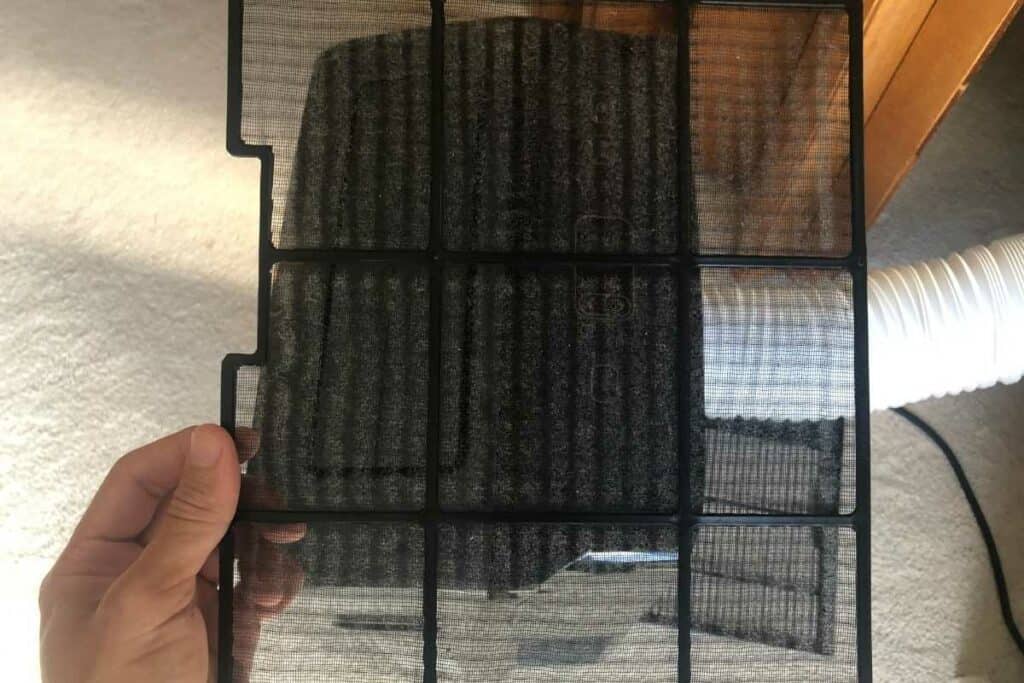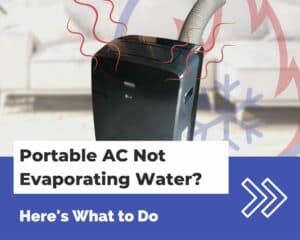Portable air conditioners provide a quick solution for cooling a room in your home. But they can often provide lackluster results—especially when it’s really hot outside.
In this article, I’ll go over a few tips and tricks to improve the cooling of your portable AC. I’ll also go over the best installation practices that you should follow when setting up your portable AC.
Clean the air filters
If your portable AC isn’t cold enough, the first thing that you should do is clean its air filters.
Dirty air filters will impede the airflow through your portable AC—causing a reduction in cooling efficiency.
Portable ACs usually have two air filters—one for the conditioned air intake, and one for the exhaust air intake.
The air filters on most portable ACs are made of a thin plastic mesh. These types of air filters are washable and reusable—so you can rinse them out with water when they get dirty.
To clean the air filters on your portable AC, follow these steps:
- Unplug your portable AC. Ensure that your portable AC is unplugged and powered down before working on it.
- Remove the plastic grilles from the air filters. The air filters should have a removable plastic grille that covers them. Remove the plastic grilles so you can access the air filters. If the plastic grilles are dirty, you can clean them with water.
- Remove the air filters. As you’re removing the air filters, keep an eye out for any built-up dust. Make sure that the dust doesn’t get all over the place or fall off the filter.
- Clean the air filters. Most portable ACs have plastic mesh filters. If this is the type of filter that your portable AC has, then you can just rinse them out with water.
When rinsing out your air filter, spray water on the filter from the inside out. What do I mean by inside out? You’ll want to spray water on the side that faces inside the AC. This makes it so that you’re pushing the dust off of the filter (instead of trying to push the dust through the filter). - Reinstall the air filters and grilles. Allow the air filters and grilles to dry out, then reinstall them into your portable AC.

Straighten and shorten the exhaust air hose
When a portable AC cools your room, it has to move all that hot air somewhere—usually outside. That’s where the exhaust hose comes into play.
The exhaust hose is responsible for directing all the hot air outside your home.
Most portable AC exhaust hoses are adjustable and collapsible—similar to dryer vent hoses.
But if the exhaust hose has any kinks, then that will impede the exhaust air from flowing outside your home.
Additionally, make the exhaust hose as short as possible. A long exhaust hose will introduce resistance to the airflow. So make sure that the hot exhaust air has a short, direct path to the outside of your home.
One last (but very important!) thing to check is that the discharge outside of your home isn’t blocked. Some homes have plants or objects outside their window that can block airflow. So check that your exhaust discharge has a clear path for airflow outside your home—and move the discharge vent if necessary.
Seal up all exhaust air leaks
If there are any air leaks in the exhaust hose, then that hot air is going right back into your home. However, most exhaust air leaks don’t occur in the exhaust hose itself—the leaks occur at the exhaust hose connections.
There are two exhaust hose connections that you need to worry about—one at the portable AC, and another at the exhaust vent (usually a window).
The first one that you need to check is the connection at the window. Ensure that the exhaust hose is secured to the vent and there are no gaps around the connection.
Next, check the connection at the portable AC. Most portable ACs should have a snug connection to the exhaust hose. But there still may be some air leaks (especially in older units).
To cover up any air leaks, apply aluminum foil tape around the gaps where the exhaust hose connects to the vent and AC.
If there are any air leaks in the exhaust hose itself, then foil tape works for that as well.
Close all doors and windows
Another way to increase the efficiency of your portable AC is to minimize the heat load in your space.
The easiest way to minimize the heat load in your space is to close all the doors and windows in your space.
Let me put it this way: How is your room ever going to cool down if warm air is constantly flowing in through the door?
By closing all the doors and windows, you minimize the amount of untreated air that infiltrates your space.
Basically, you want to make your room as closed off as possible. You can even take it one step further by closing off all the gaps around your doors, but that’s usually overkill.
Block all sunlight from entering the room
Even if all your windows are closed, loads of heat can still get inside your room—from sunlight. That’s why it’s important to block all sunlight that enters your room.
So close all your blinds and curtains when using your portable AC to ensure that the heat load from the sunlight is minimized.
If your windows don’t have blinds or curtains, then you can use a sheet to block out the light. But I would only use a sheet temporarily since they don’t do a great job at blocking out sunlight.
I recommend installing blackout curtains over your windows—they do an excellent job at blocking out sunlight.
Provide a clear air path for the AC
If your portable AC doesn’t have “room to breathe” then it won’t do a good job at cooling your room.
When picking a location to set up your portable AC, ensure that it has ample clearance in the front and behind.
I recommend AT LEAST 1 foot of clearance behind the portable AC so it has enough space for both air intakes.
The cold air discharge of your portable AC should have a clear open path toward the center of your room. This means that there shouldn’t be any obstructions in the way that block cold air flow out of your portable AC.
If there are any obstructions to airflow around your AC, then you will need to find a new location for it.





And what could be the cause if all of those things have been dealt with. I have the proper sized portable air, I have sealed all hoses. Filters are all clean. The unit isn’t actually that old just old enough to go out of warranty. It will not drop below 74° no matter where I set it. I do have central air in the house so it’s not that hot. It just won’t really get cool enough in my room and I don’t want to have to cool the entire house to sleep better. But now it’s sitting in the closet because it’s really useless for me And it’s not that old. Thanks
Hi Laura,
If your room is large, a portable AC might not be the best option. Portable ACs have trouble cooling larger spaces, especially if there is a large heat load. If you want to continue down the portable AC route, a dual-hose portable AC might be a better option since they are more efficient and don’t pull in heat from the other areas of your home.
Hope this helps,
-Trey
I put a single vent portable 10k/7k btu AC in my 34′ sailboat (about 1200 cubic ft. space), in hopes of replacing a 5k window unit. Since it pulls warm air from outside to replace the hot air it blow out, is this what accounts for the double BTU rating? Since this is a boat, not a room in a house or an apartment in a building, can it be used efficiently in this application? It seems it’s cooling effect would be almost completely offset by the amount of incoming warm air replacing the outgoing hot air.
Any advice would be greatly apriciated.
Wayne Connelly
Hi Wayne,
Some of the cooling from the portable AC will be offset by the warm air replacing the outgoing hot air, but not even close to all of it.
Nowdays, all portable ACs in the USA have two ratings – The ANSI/ASHRAE rating and the US DOE rating. The US DOE rating is lower and takes into account the offset in cooling provided by the incoming warm air from the outside.
Hope this helps,
-Trey